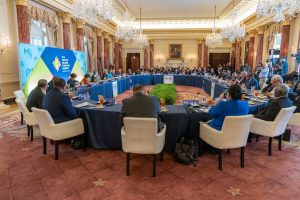It was with no small amount of personal satisfaction for me to learn of the Biden administration’s recent announcement of a U.S.-Pacific partnership strategy, the first such strategy for such an important part of the world. As ambassador under President Bill Clinton to Fiji, Tonga, Tuvalu, and Nauru, I became intimately familiar with the Pacific Islands region, an area that encompasses almost 15 percent of the earth’s surface and yet an area that has largely flown under the radar of U.S. foreign policy. In an interview with Time magazine in June 2000, I expressed my concern at the West’s apparent insouciance with the region and cautioned that disinterest on our part would be an invitation for others to partner with the island nations of this vital region.
President Joe Biden and all of those who worked hard on putting this plan together are to be congratulated for their foresight and wisdom. The strategy was worth the wait. The four major components of the plan include fostering a strong U.S.-Pacific Islands partnership by, among other initiatives, expanding our missions and increasing our diplomatic personnel in the region; forging a stronger connection between the Pacific Islands and the rest of the world by coordinating with allies and partners within and beyond the region; helping to meet the challenges, some of them no less than existential, that these islands face as a result of climate change; and empowering the people of this region to capitalize on the economic opportunities of the 21st century.
I know firsthand how important these issues are to the islanders who populate this beautiful part of the globe, many feeling as if they’ve been left behind. Initiatives we brought forth in my time there for improving their economic situation and helping to secure their islands from the encroaching dangers of climate change were always met with great enthusiasm. As ambassador and, later, in my appointment to the Board of Governors for the East-West Center in Hawaii, I saw how important our support was.
Now that a comprehensive roadmap has been laid out ensure the long-term growth, prosperity, and security of this region, I know that our Pacific Islander friends will continue to be loyal and supportive allies. It must be said that this is no small thing. China represents a real and growing threat to the region and geography inextricably links the Pacific region to the United States. Our security depends on theirs. Nature, and geopolitics, abhors a vacuum. Our involvement and influence in the area will ensure a peaceful and secure path ahead.
I celebrated the dawning of the new millennium in Fiji. Fiji is just west of the International Date Line, which means that every morning, the sun first rises over Fiji’s shores. It’s the first place on earth to experience the new day, the new year, or, in the case of the year 2000, the new millennium. In that sense it is always ahead of everyone else. And yet, in very real ways, Fiji and the rest of the Pacific Islands region have been in grave danger of falling behind the rest of the world and dangerously so. But no more. The newly developed U.S.-Pacific partnership strategy will ensure a prosperous tomorrow for Fiji and the rest of the Pacific Island region, and a secure future for all the Oceanic islands and their allies, including the United States.

































